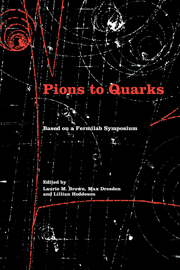Book contents
- Frontmatter
- Contents
- List of contributors
- Foreword by Leon M. Lederman
- Editors' acknowledgments
- Photographs of the symposium
- List of abbreviations
- List of notation
- I Introduction
- II Particle discoveries in cosmic rays
- III High-energy nuclear physics
- IV The new laboratory
- 9 The making of an accelerator physicist
- 10 Accelerator design and construction in the 1950s
- 11 Early history of the Cosmotron and AGS at Brookhaven
- 12 Panel on accelerators and detectors in the 1950s
- 13 Accelerators and the Midwestern Universities Research Association in the 1950s
- 14 Bubbles, sparks, and the postwar laboratory
- 15 Development of the discharge (spark) chamber in Japan in the 1950s
- 16 Early work at the Bevatron: a personal account
- 17 The discovery of the antiproton
- 18 On the antiproton discovery
- V The strange particles
- VI Weak interactions
- VII Weak interactions and parity nonconservation
- VIII The particle physics community
- IX Theories of hadrons
- X Personal overviews
- Name index
- Subject index
16 - Early work at the Bevatron: a personal account
Published online by Cambridge University Press: 07 May 2010
- Frontmatter
- Contents
- List of contributors
- Foreword by Leon M. Lederman
- Editors' acknowledgments
- Photographs of the symposium
- List of abbreviations
- List of notation
- I Introduction
- II Particle discoveries in cosmic rays
- III High-energy nuclear physics
- IV The new laboratory
- 9 The making of an accelerator physicist
- 10 Accelerator design and construction in the 1950s
- 11 Early history of the Cosmotron and AGS at Brookhaven
- 12 Panel on accelerators and detectors in the 1950s
- 13 Accelerators and the Midwestern Universities Research Association in the 1950s
- 14 Bubbles, sparks, and the postwar laboratory
- 15 Development of the discharge (spark) chamber in Japan in the 1950s
- 16 Early work at the Bevatron: a personal account
- 17 The discovery of the antiproton
- 18 On the antiproton discovery
- V The strange particles
- VI Weak interactions
- VII Weak interactions and parity nonconservation
- VIII The particle physics community
- IX Theories of hadrons
- X Personal overviews
- Name index
- Subject index
Summary
The Bevatron started operating in early 1954 at what was then the Radiation Laboratory and is now known as the Lawrence Berkeley Laboratory.
Some personal background
Sula (Sulamith Goldhaber) and I came to Berkeley from Columbia University in 1953. I joined the Physics Department and Emilio Segrè's group at the Radiation Laboratory. She joined Walter Barkas's group and later Edward Lofgren's group. We had been working with photographic emulsions at Columbia's cyclotron located at Nevis, with the help and encouragement of Gilberto Bernardini. Before that, I used emulsions loaded with D2O as a γ-ray spectrometer for my Ph.D. thesis under Hugh Richards at the University of Wisconsin in Madison.
Setting up with photographic emulsions
Whereas in my earlier work I had used 100–600-μm single small emulsions on glass, this was the period in which emulsion stacks began to be used in cosmic-ray work at Bristol and elsewhere; the electron-sensitive emulsions had recently been introduced by Kodak Ltd. of England, followed by C. Waller at Ilford, in close consultation with Cecil F. Powell and Giuseppe P. S. Occhialini.
Thus, I started out at Berkeley to build up an emulsion-processing plant in the Physics Department – the photographic-emulsion arm of the Segrè group. That involved new techniques for marking emulsion sheets, to allow easy track following from sheet to sheet, the modification of microscopes with special stages to hold and manipulate those large emulsion sheets after they were mounted precisely on glass, and the construction of accurate microscope stages for multiple scattering measurements.
- Type
- Chapter
- Information
- Pions to QuarksParticle Physics in the 1950s, pp. 260 - 272Publisher: Cambridge University PressPrint publication year: 1989
- 1
- Cited by



